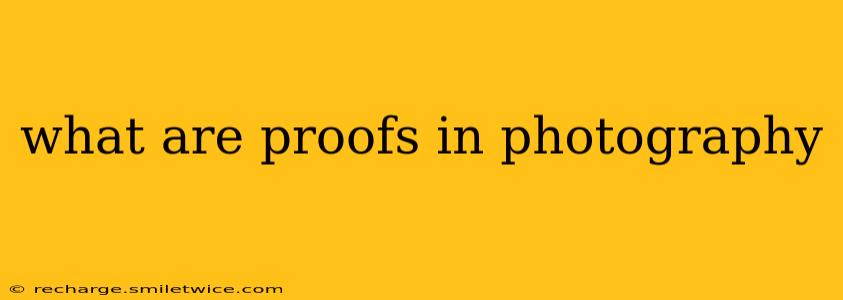In the world of photography, "proofs" aren't just about verifying something is true; they're an essential step in the photographic process, serving as a crucial bridge between the shoot and the final product. Whether you're a professional photographer or a passionate hobbyist, understanding the different types of photographic proofs and their significance is key to refining your workflow and achieving the best possible results.
What are Contact Sheets and How are They Used?
Historically, and still relevant today for certain workflows, contact sheets are a fundamental form of photographic proof. A contact sheet is a single sheet of photographic paper containing small prints of all the negatives or slides from a specific roll of film. These miniature images are arranged in a grid, allowing photographers to quickly review the entire shoot at a glance.
Think of it as a visual index of your work. Contact sheets helped photographers:
- Quickly identify successful shots: Spotting well-composed images, sharp focus, and desired expressions is made much easier.
- Choose images for further processing: Selecting images for enlargement, retouching, or other post-processing steps becomes efficient and straightforward.
- Organize and archive work: Contact sheets provide a clear record of a photographic session, simplifying the process of finding specific images later.
While digital photography has largely replaced film, the concept of the contact sheet remains vital. Digital equivalents often show thumbnails of all the images from a shoot, essentially serving the same purpose.
What are Digital Proofs and Their Benefits?
In the digital realm, proofs take on a slightly different form. Digital proofs are typically low-resolution versions of your images, sent to clients for review and selection before final editing and delivery. These digital proofs offer several key advantages:
- Client collaboration: Clients can easily browse through a selection of images and choose their favorites, offering direct feedback on composition, lighting, and overall aesthetic. This significantly reduces the risk of misunderstandings and ensures the final product aligns with the client's vision.
- Pre-editing selection: This allows photographers to focus their post-processing efforts on the chosen images, maximizing efficiency and minimizing wasted time on images that won't be used.
- Easy sharing and distribution: Digital proofs can be easily shared through online galleries or email, eliminating the need for physical prints and simplifying the review process.
What is the Difference Between a Proof and a Final Image?
The core difference lies in the level of editing and finalization. A proof is a preliminary version intended for review and selection, while a final image undergoes significant retouching, color correction, and other post-processing steps to achieve the desired aesthetic and quality. Proofs might have lower resolution or less refined editing to preserve file size and quick review time. The final image is the polished and perfected version ready for printing or online use.
What are the Different Types of Digital Proofs?
The specifics of digital proofs can vary depending on the photographer and client's needs, but common types include:
- Watermarked proofs: These feature a watermark to protect the images from unauthorized use.
- Low-resolution proofs: Smaller file sizes for faster sharing and download.
- Color-corrected proofs: While not fully edited, these proofs might show some color adjustments for client review.
- Online galleries: Web-based platforms specifically for proof sharing and client feedback.
How are Proofs Used in Professional Photography?
In professional settings, proofs are integral to client communication and project management. They help define expectations, minimize revisions, and guarantee client satisfaction. A well-organized and clearly presented set of proofs showcases a photographer's professionalism and attention to detail.
In conclusion, photographic proofs—whether contact sheets or digital galleries—are invaluable tools for both professional and amateur photographers. They streamline workflows, facilitate client communication, and ultimately contribute to producing higher-quality and more satisfying photographic results.
